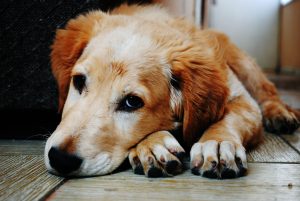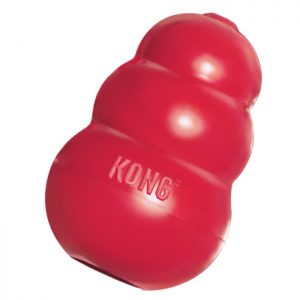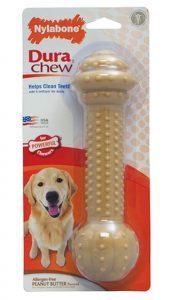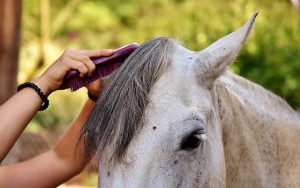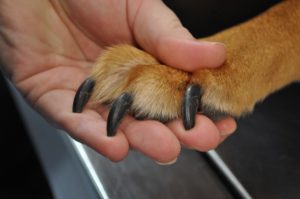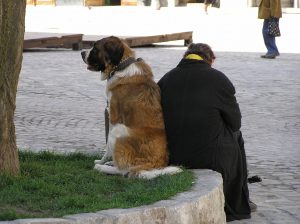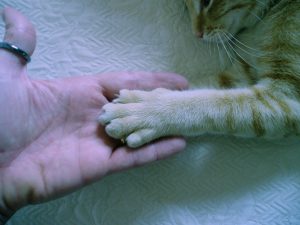Is it stressful for you (or Fido) when you’re away from home for a few hours? Does leaving for work or school in the morning leave Max nervously pacing and whining? Does coming home at the end of the day to shredded bedding or the kitchen trash strewn everywhere leave you exasperated and ready to quit your job?
Whether you’re feeling overwhelming guilt about leaving your best friend alone during the day, or if your furry companion has separation anxiety, there are ways to help you both get through the day stress-free.
Here are some tips and tricks for making your time apart peaceful, enjoyable, and positive – for both of you!
Before You Leave:
Set up your dog for success.
The old adage is so true – a tired dog is a good dog! Leave time in your morning routine to take him for a long walk or a run. Give him a chance to explore, sniff, play, and get out his energy. Does he still have a load of energy after some exercise? Purchase a dog backpack and stock the sides with canned goods, dried beans, or a handful of rocks. Strap in on your pup and have him wear it on your morning walk or run. (Of course, check with your veterinarian first to be sure that your dog can handle the load.) Bonus – by carving out time in your morning for tiring out your dog, you’ll work some exercise into your day, too!
Give him a good meal.
Don’t leave him with an empty belly! A hungry dog will only do what comes naturally to him – look for food! Your kitchen or bathroom trash, the cookie jar, and the loaf of bread on the counter look super appealing to a rumbling tummy. Revise your dog’s daily feeding routine to ensure that he’s satisfied before you leave. (And, it goes without saying – always leave a bowl of fresh water available while you’re gone.)
Consistency is key.
Make one space in your home your dog’s “room.” Use the same words each time you leave – “Time to go to your room!” or something similar – and shower him with praise when he follows your command. Great choices for a dog’s room include a spare bedroom or a kitchen with dog gates. (My dog chose her own space – the bathroom! We think she liked the cold tile floor.) In his room, set up a crate with a blanket or bedsheet over the top and leave the door open. A dark and quiet hide-out can be incredibly calming to a nervous dog.
Get to know your pet’s less-than-desirable habits, and ensure that you’ve got your bases covered.
Do you have a shredder on your hands? Confine your dog to the kitchen to spare your couch or that brand-new duvet on your bed. Does he rip apart his own bed? Choose a super-cozy orthopedic Kuranda bed instead of a fluffy bed. Used in animal shelters across the country, Kuranda beds are sturdy, easy to clean and they provide a comfortable place for a dog to rest. (Purchase directly from Kuranda and support your local rescue group at the same time! It’s a no-brainer.) Do you have a reactionary barker? Select a room that is away from street-facing windows to avoid this behavior! And, just about any dog will think the trash or last night’s take out containers to be a treasure just waiting to be discovered. Use child locks to keep your trash (and your dog) safe and keep your counters cleared of any tempting treats.
Finally, remove your dog’s collar.
By taking his collar off, you’re preventing him from getting it caught on something during the day. Horror stories of tags getting caught between crate wires will haunt any dog owner. It’s always better to be overly cautious. This being said, make sure your pet is microchipped and their collar is put back on as soon as you get home. If they somehow get lose, their collar, tags, and microchip could save their lives.
While You’re Gone:
(*Many of the suggestions provided below involve high-value food, treats and toys. Beware of any territorial behaviors and/or food aggression if you decide to leave two or more pets confined in a space together.)
Frozen bone broth treats.
What could be more delicious to a pup? Place a few pieces of kibble, small training treats, or even frozen peas into each slot of an ice cube tray. Fill up the tray with low-sodium canned or homemade bone broth. Freeze and give your pup a few as you exit. Experiment with different sizes and shapes. Silicone trays are a fun and inexpensive option. By leaving your dog with frozen treats, you’re not only his hero, but you’re ensuring that there’s nothing dangerous left behind to get lodged in his throat.
Buy a rotation of Kong toys
These durable, hard rubber toys provide hours and hours of chewing enjoyment. Even better, they’re hollow! Fill the inside of a Kong with a handful of kibble or desirable treats and stuff it with natural (no added sugar or xylitol) peanut butter. Freeze overnight. This irresistible treat will last and last while you’re running errands or off at work.
Make your own smelly sticks
Have a hardware store nearby? Maybe a Habitat for Humanity Re-Store? Ask them to cut you a few different sized lengths of PVC pipe. Drill small holes here and there along the length of the pipes and put all sorts of interesting and smelly things inside – even things that you might not want your pup to eat. A favorite in my area’s animal shelter is rabbit poop! Once filled, seal up the pipe with PVC end caps. Curious noses will love to explore the scents and roll the pipe all over the house.
Keep their mouths busy
Purchase a ready assortment of strong and durable chew toys. Try to leave your dog with things that won’t break apart or present a danger if shredded. (Those squeaky toys are fun – but are a better choice when someone’s at home to supervise.) Nylabones are a great option. The bones come in all sorts of shapes, textures, and scents.
Play soft music.
Choose a local radio station, or hop online and stream music from Spotify or Pandora. Hey, even do something as old-fashioned as playing a CD! Keep the volume low. Studies have shown that music is highly soothing and provides stress relief and results in lower cortisol levels in pets.
Keep everything else up high
Finally, remember that your dog can be just like a small child and get easily bored with the same toys. Keep a box of toys out of reach and change up his options each day.
When You Return:
Make it a calm, yet positive homecoming. You’re excited to return and your pup is so excited to see you. Do your best to keep your emotions in check and make your return home calm. If you have a jumper, avoid a full greeting until he’s stopped. The calmer you are with coming and going, the less anxiety your dog will have going forward.
If something has gone wrong during your absence – an accident on the floor, a shredded pillow or some strewn trash – learn from it and understand that no matter what, at the end of the day, he’s still an animal. Disciplining your dog after the fact won’t serve any purpose other than to make him feel nervous when you come home in the future. Next time you head out, keep the pillows out of reach, keep the trash locked up, and be sure he’s had an ample opportunity to do his business outside.
We all wish we could be with our dogs 24/7, but it just can’t be the case. With positive separations and reward-based reinforcement, you and your pup will feel better about your time apart and value your time together even more.
Finally, remember that doggie daycare at Your Pet Space is a wonderful option for most pups. Your dog will have a fun day with this best friends, and he’ll come home happy, healthy, and will most likely want to spend the rest of the evening relaxing.
Kerrie Leclair

